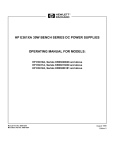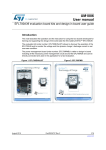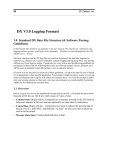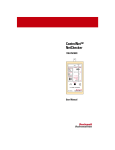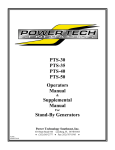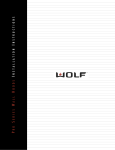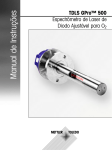Download TRIPLE OUTPUT POWER SUPPLY HP MODEL E3630A
Transcript
ü
75,3/(#287387#32:(5#6833/<
+3#02'(/#(6963$
23(5$7,1*#0$18$/
)25#,167580(176#:,7+#6(5,$/#180%(56
.5;834785;#$1'#$%29(
)RU#LQVWUXPHQWV#ZLWK#6HULDO#1XPEHUV#DERYH
.5;834785;/#D#FKDQJH#SDJH#PD\#EH#LQFOXGHG1
0DQXDO#3DUW#1R1#8<8<0865<
$XJXVW#4<<<
(GLWLRQ#9
SAFETY SUMMARY
The following general safety precautions must be observed during all phases of operation, service, and repair of this instrument.
Failure to comply with these precautions or with specific warnings elsewhere in this manual violates safety standards of design,
manufacture, and intended use of the instrument. Hewlett-Packard Company assumes no liability for the customer's failure to
comply with these requirements.
SAFETY SYMBOLS
BEFORE APPLYING POWER.
Verify that the product is set to match the available line voltage and that the correct fuse is installed.
!
GROUND THE INSTRUMENT.
This product is a Safety Class I instrument (provided with a
protective earth terminal). To minimize shock hazard, the
instrument chassis and cabinet must be connected to an
electrical ground. The instrument must be connected to the
ac power supply mains through a three-conductor power
cable, with the third wire firmly connected to an electrical
ground(safety ground) at the power outlet. Any interruption of
the protective(grounding) conductor or disconnection of the
protective earth terminal will cause a potential shock hazard
that could result in personal injury. If the instrument is to be
energized via an external autotransformer for voltage reduction, be certain that the autotransformer common terminal is
connected to the neutral(earthed pole) of the ac power lines
(supply mains).
or
Instruction manual symbol; the product
will be marked with this symbol when it is
necessary for the user to refer to the
instruction manual.
Indicate earth(ground) terminal.
The WARNING sign denotes a hazard. It
calls attention to a procedure, practice,
or the like, which, if not correctly performed or adhered to, could result inpersonal injury. Do not proceed beyond a
WARNING sign until the indicated conditions are fully understood and met.
The CAUTION sign denotes a hazard. It
calls attention to an operating procedure,
or the like, which, if not correctly performed or adhered to, could result in
damage to or destruction of part or all of
the product. Do not proceed beyond
CAUTION sign until the indicated conditions are fully understood and met.
DO NOT OPERATE IN AN EXPLOSIVE ATMOSPHERE.
Do not operate the instrument in the presence of flammable
gases or fumes.
KEEP AWAY FROM LIVE CIRCUITS.
Operating personnel must not remove instrument covers.
Component replacement and internal adjustments must be
made by qualified service personnel. Do not replace components with power cable connected. Under certain conditions,
dangerous voltages may exist even with the power cable
removed. To avoid injuries, always disconnect power, discharge circuits and remove external voltage sources before
touching components.
The NOTE sign denotes important information. It calls attention to a procedure,
practice, condition or the like, which is
essential to highlight.
DO NOT SUBSTITUTE PARTS OR MODIFY INSTRUMENT.
Because of the danger of introducing additional hazards, do
not install substitute parts or perform any unauthorized modification to the instrument. Return the instrument to a HewlettPackard Sales and Service Office for service and repair to
ensure that safety features are maintained.
DO NOT SERVICE OR ADJUST ALONE.
Do not attempt internal service or adjustment unless another
person, capable of rendering first aid and resuscitation, is
present.
Instruments that appear damaged or defective should be made inoperative and secured against unintended
operation until they can be repaired by qualified service personnel.
1-2
Table of Contents
SAFETY SUMMARY . . . . . . . . . . . . . . . . . . . . . . . . . . . . . . . . . . . . . . . . . . . . . . . . . . . . . . . . . . . . . . 1-2
GENERAL INFORMATION . . . . . . . . . . . . . . . . . . . . . . . . . . . . . . . . . . . . . . . . . . . . . . . . . . . . . . . . . 1-4
INTRODUCTION. . . . . . . . . . . . . . . . . . . . . . . . . . . . . . . . . . . . . . . . . . . . . . . . . . . . . . . . . . . . . . . . 1-4
SAFETY CONSIDERATIONS . . . . . . . . . . . . . . . . . . . . . . . . . . . . . . . . . . . . . . . . . . . . . . . . . . . . . . 1-4
SAFETY AND EMC REQUIREMENTS. . . . . . . . . . . . . . . . . . . . . . . . . . . . . . . . . . . . . . . . . . . . . . . 1-4
INSTRUMENT AND MANUAL IDENTIFICATION. . . . . . . . . . . . . . . . . . . . . . . . . . . . . . . . . . . . . . . 1-4
OPTIONS . . . . . . . . . . . . . . . . . . . . . . . . . . . . . . . . . . . . . . . . . . . . . . . . . . . . . . . . . . . . . . . . . . . . . 1-4
ACCESSORY . . . . . . . . . . . . . . . . . . . . . . . . . . . . . . . . . . . . . . . . . . . . . . . . . . . . . . . . . . . . . . . . . . 1-4
DESCRIPTION . . . . . . . . . . . . . . . . . . . . . . . . . . . . . . . . . . . . . . . . . . . . . . . . . . . . . . . . . . . . . . . . . 1-4
LINE FUSE . . . . . . . . . . . . . . . . . . . . . . . . . . . . . . . . . . . . . . . . . . . . . . . . . . . . . . . . . . . . . . . . . . . . 1-5
SPECIFICATIONS . . . . . . . . . . . . . . . . . . . . . . . . . . . . . . . . . . . . . . . . . . . . . . . . . . . . . . . . . . . . . . 1-5
INSTALLATION. . . . . . . . . . . . . . . . . . . . . . . . . . . . . . . . . . . . . . . . . . . . . . . . . . . . . . . . . . . . . . . . . . 1-6
INITIAL INSPECTION . . . . . . . . . . . . . . . . . . . . . . . . . . . . . . . . . . . . . . . . . . . . . . . . . . . . . . . . . . . . 1-6
Mechanical Check . . . . . . . . . . . . . . . . . . . . . . . . . . . . . . . . . . . . . . . . . . . . . . . . . . . . . . . . . 1-6
Electrical Check . . . . . . . . . . . . . . . . . . . . . . . . . . . . . . . . . . . . . . . . . . . . . . . . . . . . . . . . . . . 1-6
INSTALLATION DATA . . . . . . . . . . . . . . . . . . . . . . . . . . . . . . . . . . . . . . . . . . . . . . . . . . . . . . . . . . . 1-6
Location and Cooling . . . . . . . . . . . . . . . . . . . . . . . . . . . . . . . . . . . . . . . . . . . . . . . . . . . . . . . 1-6
Outline Diagram . . . . . . . . . . . . . . . . . . . . . . . . . . . . . . . . . . . . . . . . . . . . . . . . . . . . . . . . . . . 1-6
Rack Mounting . . . . . . . . . . . . . . . . . . . . . . . . . . . . . . . . . . . . . . . . . . . . . . . . . . . . . . . . . . . . 1-6
INPUT POWER REQUIREMENTS . . . . . . . . . . . . . . . . . . . . . . . . . . . . . . . . . . . . . . . . . . . . . . . . . . 1-6
Power Cable . . . . . . . . . . . . . . . . . . . . . . . . . . . . . . . . . . . . . . . . . . . . . . . . . . . . . . . . . . . . . . 1-6
OPERATING INSTRUCTIONS . . . . . . . . . . . . . . . . . . . . . . . . . . . . . . . . . . . . . . . . . . . . . . . . . . . . . . 1-6
INTRODUCTION. . . . . . . . . . . . . . . . . . . . . . . . . . . . . . . . . . . . . . . . . . . . . . . . . . . . . . . . . . . . . . . . 1-6
TURN -ON CHECKOUT PROCEDURE . . . . . . . . . . . . . . . . . . . . . . . . . . . . . . . . . . . . . . . . . . . . . . 1-7
OPERATION . . . . . . . . . . . . . . . . . . . . . . . . . . . . . . . . . . . . . . . . . . . . . . . . . . . . . . . . . . . . . . . . . . . 1-7
Tracking Ratio Control . . . . . . . . . . . . . . . . . . . . . . . . . . . . . . . . . . . . . . . . . . . . . . . . . . . . . . 1-7
Overload Protection Circuits. . . . . . . . . . . . . . . . . . . . . . . . . . . . . . . . . . . . . . . . . . . . . . . . . . 1-7
Operation Beyond Rated Output . . . . . . . . . . . . . . . . . . . . . . . . . . . . . . . . . . . . . . . . . . . . . . 1-7
Connecting Load . . . . . . . . . . . . . . . . . . . . . . . . . . . . . . . . . . . . . . . . . . . . . . . . . . . . . . . . . . 1-8
Parallel Operation. . . . . . . . . . . . . . . . . . . . . . . . . . . . . . . . . . . . . . . . . . . . . . . . . . . . . . . . . . 1-8
Series Operation. . . . . . . . . . . . . . . . . . . . . . . . . . . . . . . . . . . . . . . . . . . . . . . . . . . . . . . . . . . 1-8
LOAD CONSIDERATIONS . . . . . . . . . . . . . . . . . . . . . . . . . . . . . . . . . . . . . . . . . . . . . . . . . . . . . . . . . 1-8
PULSE LOADING . . . . . . . . . . . . . . . . . . . . . . . . . . . . . . . . . . . . . . . . . . . . . . . . . . . . . . . . . . . . . . . 1-8
REVERSE CURRENT LOADING . . . . . . . . . . . . . . . . . . . . . . . . . . . . . . . . . . . . . . . . . . . . . . . . . . . 1-8
OUTPUT CAPACITANCE . . . . . . . . . . . . . . . . . . . . . . . . . . . . . . . . . . . . . . . . . . . . . . . . . . . . . . . . . 1-8
REVERSE VOLTAGE PROTECTION . . . . . . . . . . . . . . . . . . . . . . . . . . . . . . . . . . . . . . . . . . . . . . . 1-8
1-3
GENERAL INFORMATION
between your instrument and the instrument described by this
manual. The Change Sheet may also contain information for
correcting errors in the manual.
INTRODUCTION
This section contains general information concerning the
E3630A triple output power supply. Included are safety considerations, safety and EMC requirements, instrument and
manual identification, option and accessory information,
instrument description, and specifications.
OPTIONS
Options OE3 and OE9 determine which line voltage is
selected at the factory. The standard unit is configured for 115
Vac ± 10%, 47-63 Hz input.
Option No.
OE3:
OE9:
910:
SAFETY CONSIDERATIONS
This product is a Safety Class I instrument, which means that
it is provided with a protective earth ground terminal. This terminal must be connected to an ac source that has a 3-wire
ground receptacle. Review the instrument rear panel and this
manual for safety markings and instructions before operating
the instrument. Refer to the Safety Summary page at the
beginning of this manual for a summary of general safety
information. Specific safety information is located at the
appropriate places in this manual.
Description
230 Vac ± 10%, 47-63 Hz Input
100 Vac ± 10%, 47-63 Hz Input
One additional operating and service manual
shipped with the power supply
ACCESSORY
The accessory listed below may be ordered from your local
Hewlett-Packard Sales Office either with the power supply or
separately. (Refer to the list at the rear of the manual for
address.)
SAFETY AND EMC REQUIREMENTS
This power supply is designed to comply with the following
safety and EMC(Electromagnetic Compatibility) requirements:
HP Part No.
5063-9767
The rack mount kit is needed for rack mounting of the
E3630A power supply.
IEC 1010-1(1990)/EN 61010 (1993): Safety Requirements for Electrical Equipment for Measurement, Control,
and Laboratory Use
CSA C22.2 No.231: Safety Requirements for Electrical
and Electronic Measuring and Test Equipment
UL 1244: Electrical and Electronic Measuring and Testing
Equipment
EMC Directive 89/336/EEC: Council Directive entitled
Approximation of the Laws of the Member States relating
to Electromagnetic Compatibility
EN 55011(1991) Group 1, Class B/CISPR 11 (1990): Limits and Methods of Radio Interference Characteristics of
Industrial, Scientific, and Medical(ISM) Radio - Frequency Equipment
EN 50082-1(1992) /
IEC 801-2(1991): Electrostatic Discharge Requirements
IEC 801-3(1984): Radiated Electromagnetic Field
Requirements
IEC 801-4(1988): Electrical Fast Transient/Burst
Requirements
Description
Rack Kit for mounting one or two 3 1/2" high
supplies in a standard 19" rack
DESCRIPTION
This constant-voltage/current-limiting triple output power supply combines two 0 to ±20V tracking outputs rated at 0.5
amps with an additional single output that is rated at 0 to 6
volts and 2.5 amps. The +20V and -20V tracking outputs can
also be used in series as a single 0 to 40V 0.5-amp output.
Connections to the supply's output and to chassis ground are
made to binding posts on the front panel. The supply's three
outputs share a common output terminal, which is isolated
from chassis ground so that any one output terminal can be
grounded.
All outputs are protected against overload and short-circuit
damage. The ±20V outputs are protected by circuits that limit
the output current to 110% of its nominal maximum. The overload protection circuit for the +6V output has a current foldback characteristic that reduces the output current as an
overload increases until only 1 amp flows through a short circuit. The 6V output current limit depends on the output terminal voltage and varies linearly between 2.75 amps at 6 volts
and 1 amp at zero volts.
INSTRUMENT AND MANUAL IDENTIFICATION
A serial number identifies your power supply. The serial number encodes the country of manufacture, the week of the latest significant design change, and a unique sequential
number. The letter "KR" designates Korea as the country of
manufacture, the first one digit indicates the year (3=1993,
4=1994, and so forth), and the second two digits indicate the
week. The remaining digits of the serial number are a unique,
five-digit number assigned sequentially.
All controls, digital meter, and output terminals are located on the
front panel. One voltage control sets the 0 to 6V and another
sets the voltages of the 0 to +20V and 0 to -20V outputs simultaneously. These dual tracking outputs are made more versatile
by providing a tracking ratio control in addition to the usual voltage control. With the tracking ratio control turned fully clockwise
to its "fixed" position, the dual outputs have a fixed 1:1 tracking
ratio. As the ±20V voltage control is adjusted, the voltage of the
negative supply tracks the positive output within ±1%. Turning
the tracking ratio control away from its fully clockwise position
switches the dual tracking outputs into a variable tracking ratio
If the serial number on your supply does not agree with those
on the title page of the manual, a yellow Change Sheet is
supplied with the manual to explain the difference
1-4
PRGH1#,Q#WKLV#PRGH#WKH#YROWDJH#RI#WKH#QHJDWLYH#RXWSXW#FDQ#EH#VHW
ORZHU#WKDQ#WKDW#RI#WKH#SRVLWLYH#RXWSXW1#7KH#WUDFNLQJ#UDWLR#FRQWURO
DOORZV# WKH# QHJDWLYH# VXSSO\*V# RXWSXW# WR# EH# VHW# WR# DQ\# YDOXH
EHWZHHQ#D#PD[LPXP#WKDW#LV#ZLWKLQ#“8(#RI#WKH#SRVLWLYH#VXSSO\*V
RXWSXW#DQG#D#PLQLPXP#WKDW#LV#OHVV#WKDQ#318#YROWV1#2QFH#D#UDWLR#LV
HVWDEOLVKHG#E\#WKH#WUDFNLQJ#UDWLR#FRQWURO/#WKH#UDWLR#RI#WKH#SRVLWLYH
RXWSXW#YROWDJH#WR#WKH#QHJDWLYH#RXWSXW#YROWDJH#UHPDLQV#FRQVWDQW
DV#WKH#“539#YROWDJH#FRQWURO#YDULHV#WKH#3#WR#.539#RXWSXW#RYHU#LWV
UDQJH1
DUH#DYDLODEOH#IRU#QRPLQDO#LQSXWV#RI#433#DQG#563#9DF1#7KH#VXS0
SO\#LV#IXUQLVKHG#ZLWK#D#GHWDFKDEOH#60ZLUH#JURXQGLQJ#W\SH#OLQH
FRUG1#7KH#DF#OLQH#IXVH#LV#LQ#DQ#H[WUDFWRU#W\SH#IXVHKROGHU#RQ#WKH
UHDU#KHDW#VLQN1
7KH# IURQW# SDQHO# DOVR# FRQWDLQV# D# OLQH# VZLWFK/# WKUHH# RYHUORDG
LQGLFDWRUV# IRU# .99# RXWSXW/# .539# RXWSXW/# DQG# 0539# RXWSXW/# D
YROWPHWHU# DQG# DQ# DPPHWHU/# DQG# WKUHH# SXVK0EXWWRQ# PHWHU
VZLWFKHV1# 7KH# SXVK# EXWWRQV# VHOHFW# RQH# RI# WKH# VXSSO\*V# WKUHH
RXWSXWV#IRU#GLVSOD\1#7KH#YROWPHWHU#DQG#DPPHWHU#DOZD\V#PRQL0
WRU#DQ\#RQH#VXSSO\#VLPXOWDQHRXVO\1#,Q#DGGLWLRQ#WR#WKH#VWDQGDUG
448#9DF#“#43(#7:#WR#96#+]#LQSXW/#WZR#RWKHU#OLQH#YROWDJH#RSWLRQV
/LQH#9ROWDJH
4332448#9DF
563#9DF
/,1(#)86(
7KH#OLQH#IXVH#LV#ORFDWHG#E\#WKH#DF#OLQH#UHFHSWDFOH1#&KHFN#WKH
UDWLQJ# RI# WKH# OLQH# IXVH# DQG# UHSODFH# LW# ZLWK# WKH# FRUUHFW# IXVH# LI
QHFHVVDU\#DV#LQGLFDWHG#EHORZ1#7KHVH#DUH#VORZ0EORZ#IXVHV1
)XVH
419#$
413#$
+3#3DUW#1R1
544303<4;
5443038<<
63(&,),&$7,216
7DEOH#4#OLVWV#GHWDLOHG#VSHFLILFDWLRQV#IRU#WKH#SRZHU#VXSSO\1
7DEOH#41##6SHFLILFDWLRQV
23(5$7,1*#7(03(5$785(#5$1*(
$&#,1387
6WDQGDUG= 448#9DF#“#43(/#7:096#+]/#448#9$/#;7#:
433#9DF#“#43(/#7:096#+]/#448#9$/#;7#:
2(<=
2(6=
563#9DF#“#43(/#7:096#+]/#448#9$/#;7#:
3#WR#73# R&#IRU#IXOO#UDWHG#RXWSXW1#$W#KLJKHU#WHPSHUDWXUHV/#RXW0
SXW# FXUUHQW# LV# GHUDWHG# OLQHDUO\# WR# 83(# DW# 88# R&# PD[LPXP
WHPSHUDWXUH1
'񆊛#DQG#29(5/2$'#3527(&7,21
7(03(5$785(#&2()),&,(17
3#WR#“53#9#2XWSXWV=#0D[LPXP#UDWHG#RXWSXW#FXUUHQW#LV#318#$1
6KRUW#FLUFXLW#RXWSXW#FXUUHQW#LV#3188#$#“#8(#DQG#D#IL[HG#FXU0
UHQW#OLPLW#FLUFXLW#OLPLWV#WKH#RXWSXW#RI#HDFK#VXSSO\#WR#WKLV#PD[L0
PXP#DW#DQ\#RXWSXW#YROWDJH#VHWWLQJ1#8QEDODQFHG#ORDGV#ZLWKLQ
FXUUHQW#UDWLQJ#DUH#SHUPLWWHG1#
$OO#2XWSXWV=
SHU#R&#RYHU#WKH#RSHUDWLQJ#UDQJH#IURP#3#WR#73#R&
DIWHU#63#PLQXWHV#ZDUP0XS1
67$%,/,7<#+287387#'5,)7,
$OO#2XWSXWV=
3#WR#.9#9#2XWSXW=#0D[LPXP#UDWHG#RXWSXW#FXUUHQW#LV#518#$#DW
9#91#7KH#PD[LPXP#DYDLODEOH#RXWSXW#FXUUHQW#GHFUHDVHV#ZLWK
WKH# RXWSXW# YROWDJH# VHWWLQJ1# $# FXUUHQW# IROGEDFN# FLUFXLW# OLPLWV
WKH# RXWSXW# WR# 51:8# $# “# 8(# DW# 9# YROWV# DQG/# ZLWK# GHFUHDVLQJ
YROWDJH/# UHGXFHV# WKH# FXUUHQW# OLPLW# OLQHDUO\# WR# 4# $# “# 48(# DW
]HUR#YROWV#+VKRUW#FLUFXLWHG,1
/HVV#WKDQ#314(#SOXV#8#P9#+GF#WR#53#+],#GXU0
LQJ#;#KRXUV#DW#FRQVWDQW#OLQH/#ORDG#DQG#DPELHQW
DIWHU#DQ#LQLWLDO#ZDUP0XS#WLPH#RI#63#PLQXWHV1
/2$'#75$16,(17#5(63216(#7,0(
$OO#2XWSXWV=
75$&.,1*#$&&85$&<
7KH# .53# 9# DQG# 053# 9# RXWSXWV# WUDFN# ZLWKLQ# 4(# ZLWK# WKH
75$&.,1*# UDWLR# FRQWURO# LQ# WKH# )L[HG# SRVLWLRQ1# +,Q# YDULDEOH
WUDFNLQJ# UDWLR# PRGH/# WKH# QHJDWLYH# WUDFNLQJ# RXWSXW# FDQ# EH
DGMXVWHG#IURP#OHVV#WKDQ#318#9#WR#ZLWKLQ#“8(#RI#WKH#VHWWLQJ#RI
WKH#SRVLWLYH#RXWSXW1,
/HVV# WKDQ# 83# µVHF# IRU# RXWSXW# UHFRYHU\# WR
ZLWKLQ# 48# P9# RI# QRPLQDO# RXWSXW# YROWDJH
IROORZLQJ#D#ORDG#FKDQJH#IURP#IXOO#ORDG#WR#KDOI
ORDG/#RU#YLFH#YHUVD1
287387#92/7$*(##29(56+227
$OO#2XWSXWV=
/2$'#5(*8/$7,21
#$OO#2XWSXWV= /HVV#WKDQ#3134(#SOXV#5#P9#IRU#D#IXOO#ORDG#WR
QR#ORDG#FKDQJH#LQ#RXWSXW#FXUUHQW1
'XULQJ#WXUQ0RQ#RU#WXUQ0RII#RI#DF#SRZHU/#RXWSXW
SOXV#RYHUVKRRW#ZLOO#QRW#H[FHHG#4#9#LI#WKH#RXW0
SXW#FRQWURO#LV#VHW#IRU#OHVV#WKDQ#4#91#,I#WKH#FRQ0
WURO# LV# VHW# IRU# 4# 9# RU# KLJKHU/# WKHUH# LV# QR
RYHUVKRRW1
0(7(5#$&&85$&<=#“+318(#RI#RXWSXW#.#5#FRXQWV,#DW#
###################################58R&“8R&
/,1(#5(*8/$7,21
$OO#2XWSXWV=
/HVV# WKDQ# 3135(# SOXV# 4# P9# YROWDJH# FKDQJH
/HVV#WKDQ#3134(#SOXV#5#P9#IRU#DQ\#OLQH#YROW0
DJH#FKDQJH#ZLWKLQ#UDWLQJ1
0(7(5#5(62/87,21
$OO#2XWSXW=
3$5'#+5LSSOH#DQG#1RLVH,
9ROWDJH
43#P9
#&XUUHQW 43#P$
',0(16,216
$OO#2XWSXWV=
/HVV#WKDQ#3168#P9#UPV2418#P9#S0S#+53#+]053
0+],1
&RPPRQ#0RGH#&XUUHQW#+&0,,=#/HVV##WKDQ#4#µ$#IRU#DOO#
RXWSXWV#+53#+]053#0+],1
#54516#PP:#[#;;14#PP+#[#59<15#PP'
+;1687#LQ:#[#6179<#LQ+#[#4318<4#LQ',
#:(,*+7= 61;#NJ+;17#OEV,#QHW/##814#NJ+4416#OEV,#VKLSSLQJ
408
INSTALLATION
cord plug appropriate for the user's location. Notify the nearest HP Sales and Service Office if the appropriate power cord
is not included with the supply.
INITIAL INSPECTION
Before shipment, this instrument was inspected and found to
be free of mechanical and electrical defects. As soon as the
instrument is unpacked, inspect for any damage that may
have occurred in transit. Save all packing materials until the
inspection is completed. If damage is found, a claim should
be filed with the carrier. The Hewlett-Packard Sales and Service office should be notified as soon as possible.
Mechanical Check
This check should confirm that there are no broken knobs or
connectors, that the cabinet and panel surfaces are free of
dents and scratches, and that the meter is not scratched or
cracked.
Electrical Check
Perform the TURN-ON CHECKOUT PROCEDURE in the following paragraph to confirm that the supply is operational.
Alternately, check the supply more fully using the PERFORMANCE TEST in the service information section.
INSTALLATION DATA
Figure 1. Outline Diagram
The instrument is shipped ready for bench operation. Before
applying power to the supply, please read the INPUT
POWER REQUIREMENTS paragraph.
OPERATING INSTRUCTIONS
Location and Cooling
This instrument is air cooled. Sufficient space should be
allowed so that a free flow of cooling air can reach the sides
and rear of the instrument when it is in operation. It should be
used in an area where the ambient temperature does not
INTRODUCTION
The following steps describe the use of the front panel controls and indicators illustrated in Figure 2 and serve as a brief
check that the supply is operational. Follow this checkout procedure or the more detailed performance test of service information section when the instrument is received and before it
is connected to any load equipment.
exceed 40oC.
Outline Diagram
Figure 1 illustrates the outline shape and dimensions of the
supply.
Rack Mounting
This supply may be rack mounted in a standard 19-inch rack
panel either by itself or alongside a similar unit. Please see
the ACCESSORY, page 1-4, for available rack mounting
accessory. The rack-mounting kit includes complete installation instructions.
INPUT POWER REQUIREMENTS
Depending on the line voltage option ordered, the supply is
ready to be operated from one of the power sources listed in
Table 1. A label on the rear heat sink shows the nominal input
voltage set for the supply at the factory.
Power Cable
To protect operating personnel, the supply should be
grounded. This supply is equipped with a three conductor
power cable. The third conductor is the ground conductor and
when the cable is plugged into an appropriate receptacle, the
supply is grounded.
Figure 2. Front-Panel Controls and Indicators
The power supply is equipped at the factory with a power
1-6
tor the 0 to 40V output voltage, add the voltmeter readings of
the +20V and -20V output and use either the +20V or the 20V meter to measure the current.
Before applying power to the supply, check the label on the
heat sink to make certain that the supply's line voltage option
agrees with the line voltage to be used. If the option does not
correspond to your line voltage, refer to paragraph "LINE
VOLTAGE OPTION CONVERSION" in the service section
before applying power.
Tracking Ratio Control
With the Tracking Ratio control in the Fixed position, the voltage of the -20V supply tracks that of the +20V supply within
1% for convenience in varying the symmetrical voltages
needed by operational amplifiers and other circuits using balanced positive and negative inputs.
TURN -ON CHECKOUT PROCEDURE
Turn the Tracking Ratio control counter clockwise out of the
Fixed position to set the voltage of the -20V supply lower than
that of the +20V supply. The negative supply can be set from
a minimum of less than 0.5 volts to a maximum within 5% of
the +20V supply's output. Once this is done, the ±20V voltage
control still controls both outputs and maintains a constant
ratio between their voltages.
a. Connect line cord to power source and turn LINE
switch
on.
b. Push +6V METER switch
and, with no load connected, vary +6V VOLTAGE control
over its range
and check that the voltmeter responds to the control
setting and the ammeter indicates zero.
c.
Set the +6V VOLTAGE control to 6 volts and short the
+6V output terminal
to COM (common) terminal
with an insulated test lead. The ammeter should
indicate a short-circuit output current of approximately
1.0 A. Remove the short from the output terminals.
Overload Protection Circuits
±20-Volt Current Limit. The +20V and -20V outputs are individually protected against overload or short circuit damage by
separate current limit circuits to limit the output current to 0.55
A ± 5%. (This is 110% of the maximum rated output.) If a single load is connected between the +20V and -20V outputs,
the circuit set for the lesser current limit will limit the output.
No deterioration of supply performance occurs if the output
current remains below the current limit setting.
d. Push the +20V METER switch
and turn Tracking
Ratio control
fully clockwise to the Fixed position.
With no load connected, vary ±20V VOLTAGE control
over its range and check that the voltmeter
responds to the control setting and the ammeter indicates zero.
+6V Current Foldback. The overload and short-circuit protection circuit for the +6V output reduces the output current
limit as the output terminal voltage decreases. (The operating
region of the +6V output is enclosed by heavy lines in Figure
4.) The maximum rated output current is 2.5 A and the current
limit is factory-adjusted to operate at 2.75 A ± 5% when the
output is 6 volts. At lower output voltages, the circuit reduces
the maximum obtainable output current linearly until 1 A ±
15% flows when the output is shorted. The short-circuit current can not be adjusted.
e. Set the ±20V VOLTAGE control
to 20 volts and
short the +20V output terminal
to the COM terminal
with an insulated test lead. The ammeter should
indicate a short-circuit output current of 0.55 A ± 5%.
Remove the short from the output terminals.
f.
Repeat steps (d) and (e) for -20 V output.
g. Adjust the +20V output to 20 volts. Then push -20V
METER switch and check the effect of the Tracking
Ratio control on the voltage of the -20V output. The 20V output should be adjustable from less than 0.5
volts to a maximum of 19 to 21 volts.
If this brief checkout procedure or later use of the supply
reveals a possible malfunction, see the service information
section for detailed test, troubleshooting, and adjustment procedures.
During the actual operation of the ±20V and +6V outputs, if a
load change causes the current limit to be exceeded, the OL
LED is lighted. If overload conditions occur, the ±20V supplies
will protect the load by limiting the current to 0.55 A and the
+6V supply will protect the load by reducing both voltage and
current simultaneously along the foldback locus as shown in
Figure 4. The ±20V and +6V supplies are self restoring; that
is, when the overload is removed or corrected, the output
voltage is automatically restored to the previously set value.
OPERATION
This power supply can be operated individually or in parallel
or series with another supply (see Parallel and Series Operation paragraphs). All output terminals are isolated from
ground. The ±20V and +6V outputs use a single common output terminal. This common (COM) terminal or any one of the
other output terminals may be grounded to the chassis at the
in Figure 2), or all outputs may
front panel ground terminal (
be left floating. Loads can be connected separately between
each of the 0 to ±20V output terminals and the COM terminal,
or between the -20V and the +20V terminals for a 0 to 40V
output. Each output voltage or current can be quickly selected
for monitoring with the push-button meter switches. To moni-
Operation Beyond Rated Output
The supply may be able to provide voltages and currents
greater than its rated maximum outputs if the line voltage is at
or above its nominal value. Operation can be extended up to
5% over the rated output without damage to the supply, but
performance can not be guaranteed to meet specifications in
1-7
necessary to fulfill the total current demand.
Series Operation
Series operation of two or more power supplies can be
accomplished up to the output isolation rating of any one supply to obtain a higher voltage than that available from a single
supply. Series connected supplies can be operated with one
load across both supplies or with a separate load for each
supply. The power supply has a reverse polarity diode connected across the output terminals so that if operated in
series with other supplies, damage will not occur if the load is
short-circuited or if one supply is turned on separately from its
series partners. When this connection is used, the output voltage is the sum of the voltages of the individual supplies. Each
of the individual supplies must be adjusted in order to obtain
the total output voltage.
LOAD CONSIDERATIONS
This section provides information on operating your supply
with various types of loads connected to its output.
PULSE LOADING
Figure 3. Current Limit Characteristic of the 6V Supply
The power supply will automatically cross over from constantvoltage to current-limit operation in response to an increase in
the output current over the preset limit. Although the preset
limit may be set higher than the average output current, high
peak currents (as occur in pulse loading) may exceed the
preset current limit and cause crossover to occur and
degrade performance.
this region. If the line voltage is maintained in the upper end
of the input voltage range, however, the supply probably will
operate within its specifications
Connecting Load
Each load should be connected to the power supply output
terminals using separate pairs of connecting wires. This will
minimize mutual coupling effects between loads and takes full
advantage of the low output impedance of the supply. Load
wires must be of adequately heavy gauge to maintain satisfactory regulation at the load.
REVERSE CURRENT LOADING
An active load connected to the supply may actually deliver a
reverse current to the supply during a portion of its operating
cycle. An external source can not be allowed to pump current
into the supply without risking loss of regulation and possible
damage to the output capacitor of the supply. To avoid these
effects, it is necessary to preload the supply with a dummy
load resistor so that the supply delivers current through the
entire operating cycle of the load devices.
Each pair of connecting wires should be as short as possible
and twisted or shielded to reduce noise pick-up. If a shield is
used, connect one end to the supply ground terminal and
leave the other end unconnected.
OUTPUT CAPACITANCE
If load considerations require locating output power distribution terminals at a distance from the power supply, then the
power supply output terminals should be connected to the
remote distribution terminals by a pair of twisted or shielded
wires and each load should be connected to the remote distribution terminals separately.
An internal capacitor across the output terminals of the supply
helps to supply high-current pulses of short duration during
constant-voltage operation. Any capacitance added externally will improve the pulse current capability, but will
decrease the load protection provided by the current limiting
circuit. A high-current pulse may damage load components
before the average output current is large enough to cause
the current limiting circuit to operate.
Parallel Operation
Two or more supplies can be connected in parallel to obtain a
total output current greater than that available from one supply. The total output current is the sum of the output currents
of the individual supplies. The output voltage controls of one
power supply should be set to the desired output voltage, and
the other supply set for a slightly larger output voltage. The
supply set to the lower output voltage will act as a constant
voltage source, while the supply set to the higher output will
act as a current-limited source, dropping its output voltage
until it equals that of the other supply. The constant voltage
source will deliver only that fraction of its rated output current
REVERSE VOLTAGE PROTECTION
A diode is connected across the output terminals with reverse
polarity. This diode protects the output electrolytic capacitors
and the series regulator transistors from the effects of a
reverse voltage applied across the output terminals. Since
series regulator transistors can not withstand reverse voltage
either, diodes are also connected across them. When operating supplies in parallel, these diodes protect an unenergized
supply that is in parallel with an energized supply.
1-8
Figure 4. Reverse Current Loading Solution
1-9
ü
&(57,),&$7,21
+HZOHWW03DFNDUG#++3,#&RPSDQ\#FHUWLILHV#WKDW#WKLV#SURGXFW#PHW#LWV#SXEOLVKHG#VSHFLILFDWLRQV#DW#WLPH#RI#VKLSPHQW#IURP#WKH#IDF0
WRU\1#+HZOHWW03DFNDUG#IXUWKHU#FHUWLILHV#WKDW#LWV#FDOLEUDWLRQ#PHDVXUHPHQWV#DUH#WUDFHDEOH#WR#WKH#8QLWHG#6WDWHV#1DWLRQDO#,QVWLWXWH#RI#
6WDQGDUGV#DQG#7HFKQRORJ\#+IRUPHUO\#1DWLRQDO#%XUHDX#RI#6WDQGDUGV,/#WR#WKH#H[WHQW#DOORZHG#E\#WKDW#RUJDQL]DWLRQ*V#FDOLEUDWLRQ#
IDFLOLW\/#DQG#WR#WKH#FDOLEUDWLRQ#IDFLOLWLHV#RI#RWKHU#,QWHUQDWLRQDO#6WDQGDUGV#2UJDQL]DWLRQ#PHPEHUV1
:$55$17<
7KLV#+HZOHWW03DFNDUG#KDUGZDUH#SURGXFW#LV#ZDUUDQWHG#DJDLQVW#GHIHFWV#LQ#PDWHULDO#DQG#ZRUNPDQVKLS#IRU#D#SHULRG#RI#WKUHH#\HDUV#
IURP#GDWH#RI#GHOLYHU\1#+3#VRIWZDUH#DQG#ILUPZDUH#SURGXFWV/#ZKLFK#DUH#GHVLJQDWHG#E\#+3#IRU#XVH#ZLWK#D#KDUGZDUH#SURGXFW#DQG#
ZKHQ#SURSHUO\#LQVWDOOHG#RQ#WKDW#KDUGZDUH#SURGXFW/#DUH#ZDUUDQWHG#QRW#WR#IDLO#WR#H[HFXWH#WKHLU#SURJUDPPLQJ#LQVWUXFWLRQV#GXH#WR#
GHIHFWV#LQ#PDWHULDO#DQG#ZRUNPDQVKLS#IRU#D#SHULRG#RI#<3#GD\V#IURP#GDWH#RI#GHOLYHU\1#'XULQJ#WKH#ZDUUDQW\#SHULRG/#HLWKHU#+3#RU#
+HZOHWW03DFNDUG#&RPSDQ\#ZLOO/#DW#LWV#RSWLRQ/#HLWKHU#UHSDLU#RU#UHSODFH#SURGXFWV#ZKLFK#SURYH#WR#EH#GHIHFWLYH1#+3#GRHV#QRW#ZDU0
UDQW#WKDW#RSHUDWLRQ#WKH#VRIWZDUH/#ILUPZDUH/#RU#KDUGZDUH#VKDOO#EH#XQLQWHUUXSWHG#RU#HUURU#IUHH1
)RU#ZDUUDQW\#VHUYLFH/#ZLWK#WKH#H[FHSWLRQ#RI#ZDUUDQW\#RSWLRQV/#WKLV#SURGXFW#PXVW#EH#UHWXUQHG#WR#D#VHUYLFH#IDFLOLW\#GHVLJQDWHG#E\#
+31#5HWXUQ#WR#(QJOHZRRG#&RORUDGR#6HUYLFH#&HQWHU#IRU#UHSDLU#LQ#8QLWHG#6WDWHV+40;33058;08498,1#&XVWRPHU#VKDOO#SUHSD\#VKLS0
SLQJ#FKDUJHV#E\#+DQG#VKDOO#SD\#DOO#GXW\#DQG#WD[HV,#IRU#SURGXFWV#UHWXUQHG#WR#+3#IRU#ZDUUDQW\#VHUYLFH1#([FHSW#IRU#WKH#SURGXFWV#
UHWXUQHG#WR#&XVWRPHU#IURP#DQRWKHU#FRXQWU\/#+3#VKDOO#SD\#IRU#UHWXUQ#RI#SURGXFWV#WR#&XVWRPHU1
:DUUDQW\#VHUYLFHV#RXWVLGH#WKH#FRXQWU\#RI#LQLWLDO#SXUFKDVH#DUH#LQFOXGHG#LQ#+3*V#SURGXFW#SULFH/#RQO\#LI#&XVWRPHU#SD\V#+3#LQWHUQD0
WLRQDO#SULFHV#+GHILQHG#DV#GHVWLQDWLRQ#ORFDO#FXUUHQF\#SULFH/#RU#8161#RU#*HQHYD#([SRUW#SULFH,1
,I#+3#LV#XQDEOH/#ZLWKLQ#D#UHDVRQDEOH#WLPH/#WR#UHSDLU#RU#UHSODFH#DQ\#SURGXFW#WR#FRQGLWLRQ#DV#ZDUUDQWHG/#WKH#&XVWRPHU#VKDOO#EH#
HQWLWOHG#WR#D#UHIXQG#RI#WKH#SXUFKDVH#SULFH#XSRQ#UHWXUQ#RI#WKH#SURGXFW#WR#+31
7KH#ZDUUDQW\#SHULRG#EHJLQV#RQ#WKH#GDWH#RI#GHOLYHU\#RU#RQ#WKH#GDWH#RI#LQVWDOODWLRQ#LI#LQVWDOOHG#E\#+31
/,0,7$7,21#2)#:$55$17<
7KH#IRUHJRLQJ#ZDUUDQW\#VKDOO#QRW#DSSO\#WR#GHIHFWV#UHVXOWLQJ#IURP#LPSURSHU#RU#LQDGHTXDWH#PDLQWHQDQFH#E\#WKH#&XVWRPHU/#&XV0
WRPHU0VXSSOLHG#VRIWZDUH#RU#LQWHUIDFLQJ/#XQDXWKRUL]HG#PRGLILFDWLRQ#RU#PLVXVH/#RSHUDWLRQ#RXWVLGH#RI#WKH#HQYLURQPHQWDO#VSHFLILFD0
WLRQV#IRU#WKH#SURGXFW/#RU#LPSURSHU#VLWH#SUHSDUDWLRQ#DQG#PDLQWHQDQFH1#72#7+(#(;7(17#$//2:('#%<#/2&$/#/$:/#12#
27+(5#:$55$17<#,6#(;35(66('#25#,03/,('1#$1'#+3#63(&,),&$//<#',6&/$,06#7+(#,03/,('#:$55$17,(6#
2)#0(5&+$17$%,/,7<#$1'#),71(66#)25#$#3$57,&8/$5#385326(1
)RU#FRQVXPHU#WUDQVDFWLRQV#LQ#$XVWUDOLD#DQG#1HZ#=HDODQG=#
7KH#ZDUUDQW\#WHUPV#FRQWDLQHG#LQ#WKLV#VWDWHPHQW/#H[FHSW#WR#WKH#H[WHQW#ODZIXOO\#SHUPLWWHG/#GR#QRW#H[FOXGH/#UHVWULFW#RU#PRGLI\#DQG#
DUH#LQ#DGGLWLRQ#WR#WKH#PDQGDWRU\#ULJKWV#DSSOLFDEOH#WR#WKH#VDOH#RI#WKLV#SURGXFW#WR#\RX1
(;&/86,9(#5(0(',(6
72#7+(#(;7(17#$//2:('#%<#/2&$/#/$:/#7+(#5(0(',(6#3529,'('#+(5(,1#$5(#7+(#&86720(5*6#62/(#$1'#
(;&/86,9(#5(0(',(61#+3#6+$//#127#%(#/,$%/(#)25#$1<#',5(&7/#,1',5(&7/#63(&,$//#,1&,'(17$//#25#&216(0
48(17,$/#'$0$*(6/#:+(7+(5#%$6('#21#&2175$&7/#7257/#25#$1<#27+(5#/(*$/#7+(25<1
$66,67$1&(
7KH#DERYH#VWDWHPHQWV#DSSO\#RQO\#WR#WKH#VWDQGDUG#SURGXFW#ZDUUDQW\1#:DUUDQW\#RSWLRQV/#H[WHQGHG#VXSSRUW#FRQWDFWV/#SURGXFW#
PDLQWHQDQFH#DJUHHPHQWV#DQG#FXVWRPHU#DVVLVWDQFH#DJUHHPHQWV#DUH#DOVR#DYDLODEOH1#&RQWDFW#\RXU#QHDUHVW#+HZOHWW03DFNDUG#
6DOHV#DQG#6HUYLFH#RIILFH#IRU#IXUWKHU#LQIRUPDWLRQ#RQ#+3*V#IXOO#OLQH#RI#6XSSRUW#3URJUDPV1
Manual Update
The information in this manual update is provided to correct manual errors and to adapt the manual
to instruments containing changes after the manual print date.
Manual Identification
This update is used with the Operating and Service Manual of the E3630A Triple Output Lab
Bench DC Power supply; Manual Part Number: 5959-5329, Manual Print Date: August 1999 (Edition 6).
For Instruments with Serial Numbers > KR71810198
Change 1:
On page 1-5, change the Meter Accuracy Specification at the Table 1 as follows:
From: ± 0.5 % of full scale + 2 counts at 25 °C ± 5 °C
To:
± (0.5 % of output + 2 counts) at 25 °C ± 5 °C
Ó
Copyright Hewlett-Packard Company 1999
Printed in Korea August 1999 E0899
*E3630-90092*
E3630-90092













